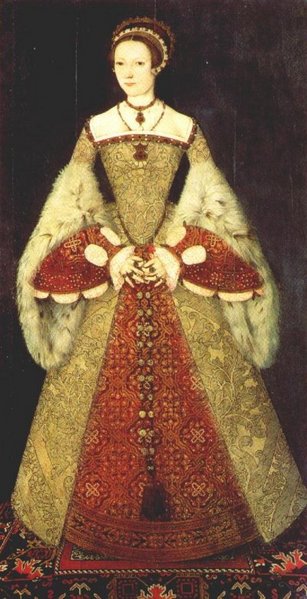Farthingale - Definitions of Farthingale for the Clothing Industry presented by Apparel Search
Fashion Directory Definition List Fashion Industry News Clothing Industry Glossary
|
|
Farthingale is a term applied to any of several structures used under Western European women's clothing in the late fifteenth and sixteenth centuries to support the skirts into the desired shape.
Spanish farthingale
The Spanish farthingale was a hoop skirt stiffened with osiers (willow cuttings), rope, bent, or (from about 1580) whalebone. The name comes from Spanish verdugo 'green wood'.
The earliest primary sources indicate that Princess Isabel of Portugal brought verdugadas with 14 hoops each with her to Spain on her marriage in the 1470s. The Spanish princess Catherine of Aragon brought the fashion into England on her marriage to Prince Arthur, eldest son of Henry VII in 1501.
Spanish farthingales were an essential element of Tudor fashion in England, and remained a fixture of conservative Spanish court fashion into the early seventeenth century (see Portrait of Queen Margaret of Austria, 1609).
French farthingale
The French farthingale is properly a crescent- or sausage-shaped pad stiffened with bent or whalebone and tied around the waist under the skirts; the resulting silhouette is broad and rounded over the hips with the skirt hanging freely in folds.
This type of French farthingale seems to be the item called a roll in Elizabeth I's wardobe accounts. It is the origin of the bumroll worn by Elizabethan recreationists.
The term French farthingale is also used for the wheel or drum farthingale, a stiffened circular support for the drum-shaped silhouette worn in England the 1590s.
The farthingale is the ancestor of eighteenth century panniers and of the nineteenth century crinoline.
Fashion History
| The above article is licensed under the GNU Free Documentation License. From Wikipedia, the free encyclopedia (https://en.wikipedia.org/wiki/farthingale). 1/6/06 |
| Discussion boards are a great place to meet other members of the fashion industry, get advice, and share information. This forum was created to discuss the topic of this page. If you have questions, or information to improve this page, please join in the community discussion below. Please keep the communication on topic and for the purpose of education. |
|
|
 |
|
|
|
| Fashion Industry |
|
|
